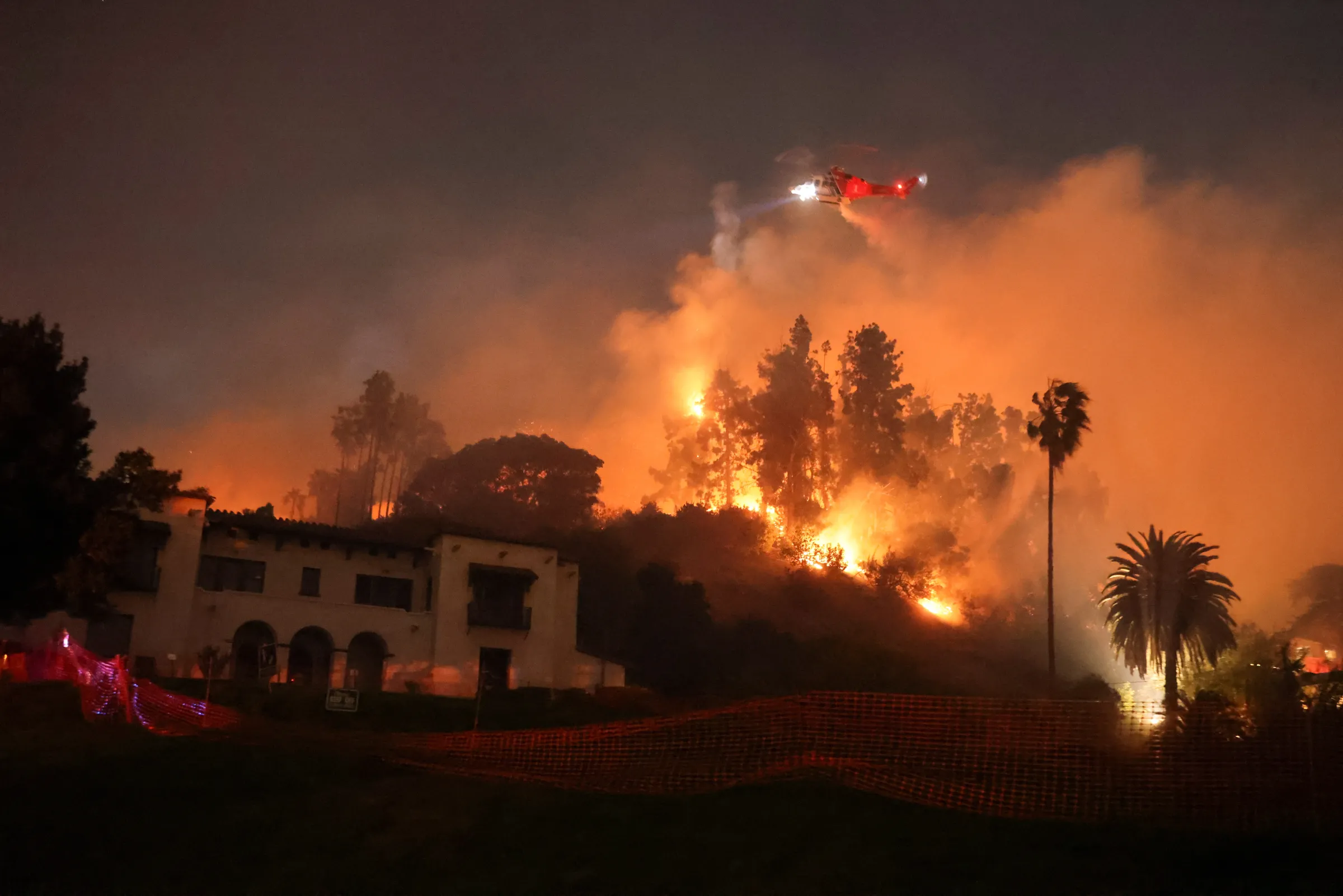Is the U.S. prepared for the wildfire season?

A firefighter extinguishes the fire as the Palisades Fire burns in Mandeville Canyon, a neighborhood of Los Angeles, California, U.S., January 12, 2025. REUTERS/Ringo Chiu
What’s the context?
With wildfire season threatening the western United States, alarms are sounding over understaffed weather forecast agency.
- Federal U.S. weather forecast agency understaffed
- Elevated wildfire risk seen for parts of U.S.
- Certain training for meteorologists scrapped
LOS ANGELES - As wildfire season gets underway, the U.S. government agency tasked with providing weather forecasts and warnings used by firefighters and emergency response teams is operating with a slashed budget and staff.
Under the administration of President Donald Trump, job cuts, buyouts and voluntary retirements have slashed about 600 National Weather Service (NWS) staff that fire departments rely upon to receive precise weather forecasts and warn the public, according to Alex Tardy, a former NWS warning coordination meteorologist.
With much of the U.S. Southwest and Northwest facing extreme wildfire conditions due to low winter rainfall as well as intense heat waves projected for summer, federal, state and local fire departments will need the NWS more than ever, Tardy said.
Yet some western U.S. NWS offices are operating with only about half of their regular number of staff, Tardy said.
"We weren't fully staffed to begin with, and when you already are short people, that's the big fear this year," said Tardy, who took voluntary retirement from the San Diego, California NWS office in May. "This all has a trickle-down effect from top to bottom."
"You hope there's going to be no fires and no hurricanes, but in reality we know that's not going to be the case," he told Context. "We're going to have a lot of wildfires if the forecast is anywhere close."
When large wildfires explode, emergency management teams comprised typically of federal, state and local firefighting departments request an incident meteorologist (IMET) from a regional NWS office who is a specialist in forecasting fire weather.
NWS meteorologists volunteer for two years of extra training to become IMETs and travel to command posts near fires to work alongside emergency responders.
Experts say now there are not enough of them.
"I'm really worried about the IMET situation this year," said Jim Whittington, a retired public affairs officer with the federal Bureau of Land Management (BLM) that manages thousands of square miles of western U.S. land.
"They're absolutely critical because they're essentially giving you those spot forecasts for the entire fire constantly," he said.
The NWS currently has about 90 fire-trained IMETs out of a total staff – after layoffs and cuts – of roughly 2,900, according to Tardy.
But those 90 are not available all the time, adjusting for sick leave, vacation or other time off.
"So even though I say there's 90 available for any wildfire in the West, that number often is more like 20," Tardy said.
In a busy fire year, dozens of large blazes can explode at once in different states.
Tardy said because the NWS was already understaffed before Trump's cuts, offices such as the one in Sacramento, California was short by at least seven meteorologists as of May.
When IMETs are sent to the field, employees left in a severely understaffed office would have to cover more shifts, leading to burnout and resignations, Tardy said.
In addition, the Trump administration in March cancelled this year's IMET training, effectively cutting the pipeline for new specialists and the recertification of existing ones.
"Cancelling training like that is huge," Tardy said.
"There's really no true substitute … these are integral, critical components to making sure our meteorologists are trained and safe," he added.
'Fire years'
Large wildfires cost the United States an average of $6.2 billion apiece, according to the National Centers for Environmental Information.
As worsening climate change fuels wildfires, even the term "fire season" no longer applies, Whittington said.
"We're trying to get away from fire season and talk about fire years," he said, noting that the BLM routinely manages wildland fires that spread over tens of thousands of acres.
"From our perspective, it all rolls into one," he said. "We are having a longer period where we have large fires on the landscape.
"That's starting earlier, that's ending later."
While the western U.S. faces wildfires, the other half of the country is bracing for hurricane season that began June 1 and lasts through November.
In early June, the NWS announced it would hire 125 people after an above-normal hurricane season prediction sparked concern.
This year's season is expected to bring as many as 10 hurricanes, according to the National Oceanic and Atmospheric Administration (NOAA), which includes the NWS.
One former official who spoke on background said he was concerned most of those hires would go to offices in the eastern U.S., leaving the West understaffed.
In a written statement to Context on June 10, NOAA said it was working to reassign people to NWS offices "with the greatest operational need" and it is "taking steps" to address gaps left by early retirement.
"Additionally, a targeted number of permanent, mission-critical field positions will soon be advertised under an exception to the Department-wide hiring freeze to further stabilize frontline operations," it said.
On June 4, Commerce Secretary Howard Lutnick told a Senate hearing that NOAA was "fully staffed" with weather forecasters and scientists after concerns were raised about some offices losing 24-hour staffing ahead of hurricane season.
(Reporting by Rachel Parsons. Editing by Anastasia Moloney and Ellen Wulfhorst.)
Context is powered by the Thomson Reuters Foundation Newsroom.
Our Standards: Thomson Reuters Trust Principles
Tags
- Extreme weather
- Future of work
- Forests


















